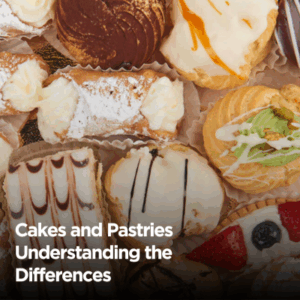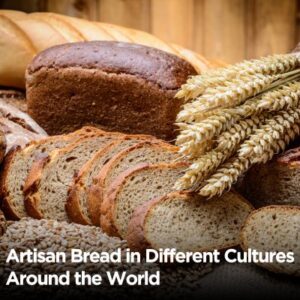In France, bakeries are not just places to buy bread but an essential part of the country’s culinary tradition.
As you walk through the streets of Paris or a small village, you’ll come across two types of bakeries: boulangeries and pâtisseries. While both serve delicious baked goods, there are distinct differences between them.
For many food lovers and tourists, the difference between a boulangerie and a patisserie can be hard to figure out. Both offer baked treats, but each specializes in different products and operates under its guidelines.
In this blog, we’ll explain what sets these two types of bakeries apart, from what they offer to their cultural roles in French life. Whether you’re planning a trip to France or want to learn more about French baking, this guide will help clear up the confusion.
What is a Boulangerie?
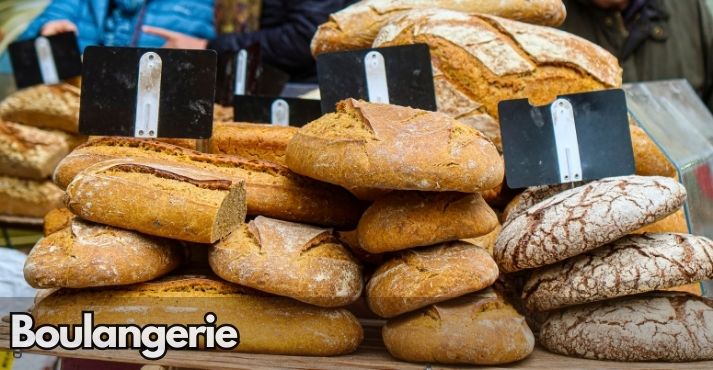
A boulangerie is a French bakery specializing in bread and other yeast-based baked goods. The word comes from “boulanger,” which means baker.
In the boulangerie vs. patisserie conversation, this place is dedicated to crafting everyday breads — not overly sweet or decorative, just expertly made dough, time, and tradition.
In France, bread isn’t just a side item but a daily essential. Around 12 million customers visit a boulangerie daily to pick up their bread, showing how deeply these bakeries are woven into everyday life.
Legal Designation in France
The title boulangerie is protected by French law. A bakery can only use it if bread is made on-site from raw ingredients, such as flour, water, salt, and yeast. Using pre-made or frozen dough is not allowed. This helps protect the quality and authenticity of traditional French baking.
Common Items Found in a Boulangerie
If you walk into a boulangerie, you’ll be met with the warm aroma of fresh bread. Each loaf carries its tasting notes, depending on the type of flour, fermentation, and baking technique. You’ll typically find:
- Baguettes – crisp crust and soft interior, a daily staple for many households.
- Pain de campagne – rustic country bread, often made with a mix of white and whole grain flours.
- Pain complet – whole wheat bread with a dense crumb and nutty flavor.
- Ficelle, batard, and other regional styles – offering variety in shape, size, and texture.
These breads aren’t reserved for special occasions. Instead, they’re part of everyday meals, from breakfast through dinner.
What is a Patisserie?
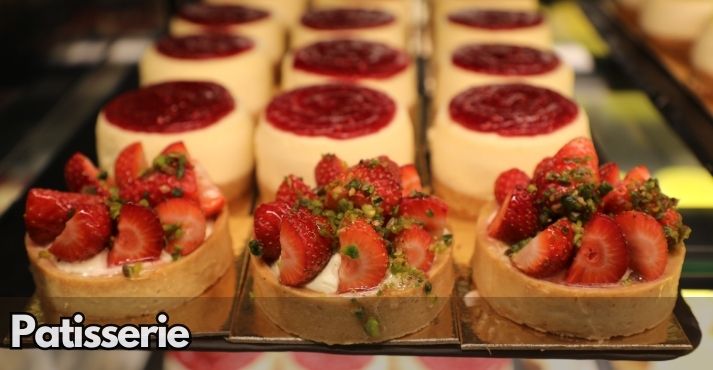
A patisserie is a French bakery specializing in sweet baked goods and refined desserts. The word comes from “pâtissier,” meaning pastry chef, an expert trained in creating elegant, often intricate confections.
When comparing different types of French bakeries, the patisserie stands out for its focus on sweets rather than bread.
While a boulangerie caters to daily staples like baguettes, a patisserie is where you go for indulgent desserts that are as much about beauty as they are about flavor.
Legal Recognition and Professional Title
You can’t just open a patisserie in France because you enjoy baking. The title is legally protected. Only those who have completed formal training and received certification as a pâtissier can operate a patisserie.
This ensures a high standard of skill, especially since the techniques involved often require precise handling, temperature control, and presentation.
So if you’re visiting a shop labeled as a patisserie in France, you’re not just stepping into a dessert shop. You’re entering a space run by a certified professional with significant knowledge of French pastry traditions.
Common Items Found in a Patisserie
Patisseries offer a stunning display of sweets far beyond the average bakery. Many of these treats are considered popular pastries worldwide because of their artistry and taste. Some of the most common items include:
- Éclairs, mille-feuille, and fruit tarts – each filled or topped with smooth creams, custards, or seasonal fruits.
- Opera cakes, choux pastries, and macarons – delicate, layered, and balanced in texture and flavor.
- Seasonal pastries and elegant fruit-based desserts – often featuring glazes, mousses, and sculpted elements.
The difference between a bakery and a patisserie comes down to specialization. While a bakery might offer a mix of items, a patisserie is singularly focused on sweets, with precision, creativity, and flair.
Boulangerie vs. Patisserie: Key Differences
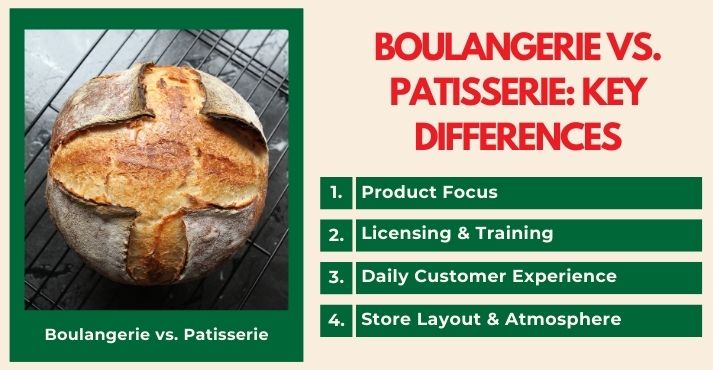
Though both are pillars of French culinary heritage, the patisserie and boulangerie operate under different rules, serve different products, and offer different customer experiences.
Knowing how patisserie differs from boulangerie helps you order the right treat and gives you a window into France’s rich food culture.
Here’s a side-by-side comparison:
[fusion_table fusion_table_type=”1″ fusion_table_rows=”” fusion_table_columns=”” margin_top=”” margin_right=”” margin_bottom=”” margin_left=”” hide_on_mobile=”small-visibility,medium-visibility,large-visibility” class=”” id=”” animation_type=”” animation_direction=”left” animation_speed=”0.3″ animation_offset=””]
| Category | Boulangerie | Patisserie |
|---|---|---|
| Product Focus | Breads and rustic, dough-based items | Refined, sweet, sugar-based pastries |
| Licensing & Training | Must bake all bread on-site | Run by certified pastry chefs (pâtissiers) |
| Customer Experience | Opens early for daily bread purchases | Opens later, focused on indulgent treats |
| Store Atmosphere | Practical, often minimalist or rustic | Elegant, visually curated for dessert displays |
[/fusion_table]
1. Product Focus
Boulangeries specialize in yeast-based baked goods like baguettes, pain complet, and country-style loaves. These breads are staples in French households, often bought fresh every day.
The baking process emphasizes fermentation, crust quality, and hearty textures, perfect for sandwiches or the dinner table.
Meanwhile, patisseries are devoted to sweet craftsmanship. Offerings like éclairs, mille-feuille, and tarts focus on balance, delicate layering, and artistic finishes.
These aren’t everyday basics but luxurious desserts created for pleasure and presentation, often taking hours to prepare.
2. Licensing & Training
Legal requirements are strict for both. A boulangerie must bake its bread from scratch on-site, starting from raw ingredients like flour, water, yeast, and salt.
It cannot sell bread made from frozen dough or prepared elsewhere. This law protects traditional craftsmanship and ensures freshness.
A patisserie, however, demands formal certification. Only trained pâtissiers, who undergo rigorous schooling and apprenticeships, can legally operate a patisserie in France.
This ensures that the shop’s offerings meet high standards in both skill and safety, and reflects the precision needed to execute technically complex desserts.
This dedication to professional excellence is reflected in the respected bakery and pastry trade shows, where artisans, chefs, and industry leaders come together to showcase innovations, share techniques, and celebrate the art of baking.
3. Daily Customer Experience
For many locals, the day begins with a trip to the boulangerie. Open as early as 6 or 7 a.m., these bakeries cater to the morning rush, serving hot baguettes, croissants, and pain au lait. Their role is practical and habitual: fresh bread is essential in French homes.
Patisseries tend to open later; their experience is more about indulgence than necessity. Customers often browse leisurely, choosing desserts for celebrations, gifts, or special occasions. The experience is slower-paced and visual, with each pastry styled for maximum impact.
This pattern also connects to menu psychology. Boulangeries provide everyday staples, while patisseries use variety, color, and design to encourage exploration and impulse buying.
4. Store Layout and Atmosphere
The layout of a boulangerie is typically functional: counters, bread racks, and a straightforward customer flow. It’s designed to handle high foot traffic efficiently, with little emphasis on decoration.
A patisserie, on the other hand, leans into elegance. Glass displays are carefully lit to highlight the details of each item, and the ambiance often feels closer to a boutique than a bakery. Some patisseries even incorporate seating, encouraging guests to enjoy their desserts on-site.
This visual emphasis helps communicate the product’s value. It’s another way the difference between a bakery and a patisserie is reflected in the customer experience.
What is Viennoiserie?
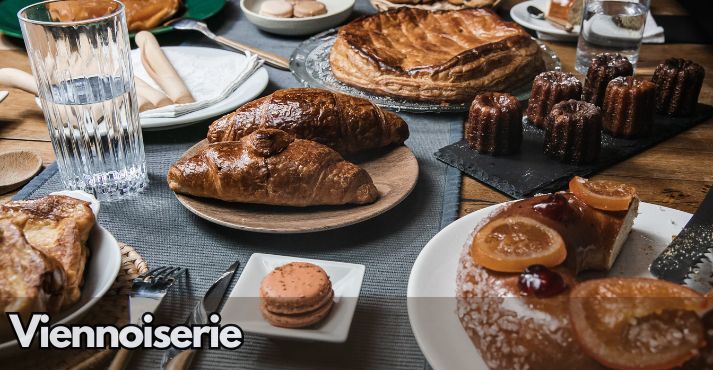
Viennoiserie is a category of baked goods between bread and pastry. These items are usually made with yeast-leavened dough like bread but enriched with butter, sugar, and eggs, giving them the sweetness and richness associated with pastries.
While viennoiseries require techniques from both worlds, they aren’t classified as an authentic boulangerie or patisserie product. Instead, they combine the bread structure with the indulgence of pastry, making them a staple of morning routines and café culture.
Common Viennoiserie Items
Viennoiseries are commonly found in boulangeries and patisseries, often displayed up front to tempt early-morning customers. Popular examples include:
- Croissants – Buttery, flaky, and iconic.
- Pain au chocolat – Similar to a croissant but filled with chocolate.
- Brioche – Soft and slightly sweet, perfect on its own or as a sandwich base.
- Danish pastries – Often topped with custard, fruit, or icing.
- Chausson aux pommes – A puff pastry filled with apple compote, similar to an apple turnover.
These items are a go-to for breakfast or a light snack, offering a bit of indulgence without being overly sweet.
Boulangerie and Patisserie Outside of France
Beyond France, the terms boulangerie and patisserie are often used more loosely. While they carry a sense of European craftsmanship, their use isn’t regulated like in France. That means the name on the sign might not tell the whole story.
Usage in Singapore and Globally
Boulangerie and patisserie are often used for branding in places like Singapore and other international markets.
There are no legal requirements around who can use the terms, so many establishments offer both types of products, fresh bread, croissants, tarts, and cakes, under a single roof.
As a result, the line between boulangerie and patisserie products can blur, especially when artisan quality isn’t guaranteed.
What to Look For
Look for signs of in-house production to spot a bakery that follows true French tradition. Ask whether the bread and pastries are baked on-site from scratch. High-quality ingredients, proper baking techniques, and visible attention to detail are all good indicators.
If a shop employs a trained pastry chef or highlights specific regional specialties, that’s often a strong signal of authenticity.
Which Should You Visit? Boulangerie or Patisserie?
If you’re visiting France or stepping into a French-style bakery elsewhere, it’s worth experiencing both a boulangerie and a patisserie. Each offers something different, and the best choice depends on the moment.
Start your day with a trip to the boulangerie. A warm baguette or rustic loaf is a simple pleasure that locals enjoy daily. Later on, when you’re in the mood for a treat, head to the patisserie for a delicate éclair or a slice of opera cake.
Many of these bakeries follow long-standing traditions and are often run by professionals with hospitality training. That background helps create not just great food, but a memorable experience.
In the end, it’s not about choosing one over the other. It’s about enjoying what each has to offer.
Boulangerie vs. Patisserie vs. Viennoiserie Comparison
[fusion_table fusion_table_type=”1″ fusion_table_rows=”” fusion_table_columns=”” margin_top=”” margin_right=”” margin_bottom=”” margin_left=”” hide_on_mobile=”small-visibility,medium-visibility,large-visibility” class=”” id=”” animation_type=”” animation_direction=”left” animation_speed=”0.3″ animation_offset=””]
| Category | Boulangerie | Patisserie | Viennoiserie |
|---|---|---|---|
| Primary Products | Breads like baguette, pain de campagne | Pastries like éclairs, tarts, macarons | Croissants, brioche, pain au chocolat |
| Legal Requirements | Must bake bread on-site from raw ingredients | Must be licensed and run by a certified pâtissier | No separate legal category; included in both types |
| Chef Qualifications | Trained bakers (boulanger) | Certified pastry chefs (pâtissiers) | Often prepared by either bakers or pastry chefs |
| Where Sold | Primarily in boulangeries | Primarily in patisseries | Commonly found in both boulangeries and patisseries |
[/fusion_table]
Conclusion
Boulangeries and patisseries are more than just places to buy bread or dessert. They represent centuries of French culinary heritage. Each has its rhythm, traditions, and specialties that reflect the country’s deep respect for craft and quality.
By understanding the difference between them, from legal standards to the kinds of products offered, you can experience French baking with greater insight and even a deeper appreciation for that flaky croissant or perfectly crisp baguette.
Whether traveling or enjoying French-style baking at home, knowing what each offers helps you savor every bite.



